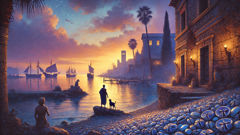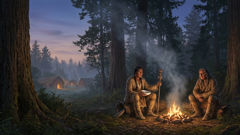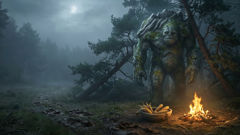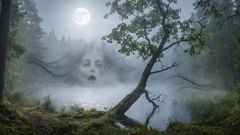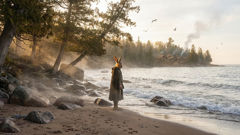Introduction
On the edge of the ancient world, where cedar forests press the horizon and the sea wears purple like a cloak, Tyre stood as both doorway and treasury. The harbor breathed with the rhythm of ships, and the streets tasted of resin and salt, of cumin and seaweed, of merchants arguing over weights and tides. It is here that a story begins not with kings or priests, but with a patient dog named Argos, and with Heracles, the hero whose name still carried the echo of trials endured and risk endured again. Argos was no champion in the arena of bronze and spear; his strength lay in a quiet gaze that could hold a storm, his ears attuned to the whispered currents of the coast. He followed Heracles across the sands and along the quay, nose-to-ground, turning over shells and stories as if the world itself were a coastline of legends waiting to be opened. The myth that will unfold is not a simple fable about wealth but a woven tapestry of patience, humility, and an odd little accident that changed a city’s course. If you listen closely, you can hear the soft hiss of the Tyrian sea smoothing the stones, the chorus of fishermen mending nets, and the almost ceremonial tapping of snail shells as the craft of purple dye—so coveted, so costly, so wrapped in ritual—begins to take shape in the hands of the world. It is a tale that will insist that every wealth has a source, and every source lives in small, patient things. A paw prints a secret into the sand, and the rest follows like a tide. It is a myth that invites you to watch not only the dye staining cloth but the moral dye staining a culture: that fortune often grows where curiosity and mercy meet, where animals, trusted companions, and human ambition cross paths at the very edge of the sea.
Section 1 — The Search, The Snail, and The Bark
The first chapter of the myth does not begin with a decree, a treaty, or a royal edict. It begins with a dog’s quiet curiosity and a hero’s tempered patience. Heracles has come to Tyre to seek counsel from sailors who know the sea as if it were a map written in salt. He travels with Argos, a dog who does not boast of speed but carries a gaze that seems to count the breaths of the world. The coast is crowded with the small economies of men who trade shells, cords, and the promises of all colors. Yet it is the humble snail, the murex, that holds the naked center of the tale. In a low cove where kelp drapes the rocks like a green curtain, Argos noses a bend in the shore and noses again, tracing a trail of glistening fragments. He finds a scatter of shells and a handful of mollusks that have been mislaid by the sea’s patient hunger. The moment is not loud. It happens when a single shell, pressed by a wave, releases a scent as rich as dusk and as old as the sea itself. The dog’s paw lands with a soft, decisive thud on a cluster of shells, and purple liquid seeps across the stone, staining it the color of a secret moon. Heracles watches, not with astonishment but with a scholar’s curiosity. In his memory, dye is a story passed down by weavers and merchants, a thing that can turn cloth into a language. Argos, with the stubborn simplicity of a creature who does not yet know its impact, taps another shell with a careful paw. A drop spills, and the color glows in the sunlight, a rumor of a hue that has never sat so boldly on stone before. The dog’s instinct is not to hoard the color but to demonstrate it, as if to say, See, color is not merely a pigment; it is a consequence of listening to the sea’s patient rituals. The little discovery grows into a ritual: rinse, test, repeat—work the shell, watch the change, learn the pace of the dye’s blush. The fishermen, watching from a distance, sense that something ancient is stirring in the air, that a new craft might be born from a single moment of paw and tide. This is the seed of Tyre’s wealth, a wealth that does not come quickly, but through repetition, care, and the dog’s unassuming fidelity. The myth does not pretend the dyes sprang from a single, dramatic revelation; it whispers that knowledge often shows up as a quiet ripple, widening as more shells are opened, more drops fall, more cloth darkens, and more people believe that money can grow from routine observation rather than royal decree. By the time the sun settles into a thin gold coin on the water, Argos has not only found the pigment but introduced a humility into Heracles’ journey: the most valuable secret is often a patient one, carried home by a dog who knows how to listen to the sea’s slow language.
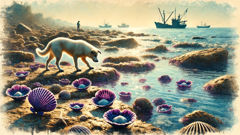
Section 2 — The Emergence of Color and a City’s Quiet Rise
Section 2 deepens the act of discovery and begins to stitch together the city’s fate with the sea’s secrets. The dye is not merely a pigment; it is a language, and Tyre’s sailors become translators. The process is patient and exacting: the murex shells must be fermented, mashed, and coaxed into a paste that will release its crown of color only with careful heat and a patient eye. Argos continues to appear wherever the dyes are tested: he sits respectfully by the hearth as women and men wash, grind, and test, the air heavy with faint coppery fragrance and the hiss of boiling vinegar. Heracles, ever the hero, listens to the sailors’ stories and learns to recognize the rhythms of wealth that the sea permits. In one autumn, a master dyer, a quiet man who speaks more with his hands than with words, drapes a cloak over a dummy for testing. The purple hue blooms across the fabric as if the night itself had chosen to wear a sunrise. The dye is not stable yet; it changes with light and air, so the craftspeople must calibrate the shade by season and sun. Argos does not understand the theory of chemistry, but his instinct helps to protect the vessels and the jars that hold the precious paste. He sits at the threshold of the workshop and guards the doorway with a calm, faithful watchfulness, a posture that makes a circle of trust with the dyers inside. The city begins to listen to the color’s mood—the purple that speaks of royalty in the cloth and of humble, patient craft in the making. It is a dye born from the sea and kept by the hands that have learned to coax beauty from a single drop. The myth’s voice grows louder as Tyre’s merchants realize that they hold not just pigment but a passport: the color that travels with ships past the Levant, past the Aegean, past every sea that knows a kingdom’s vanity. The dog’s role evolves from a curious wanderer to a guardian of a secret, a silent ambassador for a craft that could bind a city’s fortune to the world’s appetite for beauty. When Argos sits by the loom while a weaver works, the workers smile, seeing in him a reminder that the dye’s life is a shared burden and a shared gift. The tale of Argos, of his pawprints on a rock and his breath on a jar, becomes the city’s quiet creed: that wealth grows where patience and humility meet, where a dog’s quiet watch can save a nation from the wreck of sudden fortune, and where color—beautiful, stubborn, particular color—can bind a people across generations.
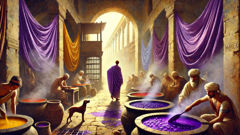
Conclusion
Thus the myth resolves not in a single burst of gold but in a city’s settled breath. Tyre learned to weigh its wealth with the same care the dyers gave to the paste that colored their cloths. The dye did not merely color garments; it altered how people looked upon power, how rulers weighed decisions, and how a distant sea could shape a city’s identity. The dog, Argos, faded from the stage of human chronicle, yet his shadow lingered in every dyed thread, in every market stall where someone asked for a shade that could endure sun and spray, and in every lullaby told to children about the night skies over Tyre. The moral remains clear: wisdom often wears the fur of humility, and wealth, when tied to craft and patience, is a story that refuses to end. If you seek Tyre’s old wealth today, you do not travel only toward marble quays or well-waxed ledgers; you walk toward the memory of a dog who walked the shore, sniffed the sea, and reminded a city that color is born of listening as much as it is born of shell and salt.

